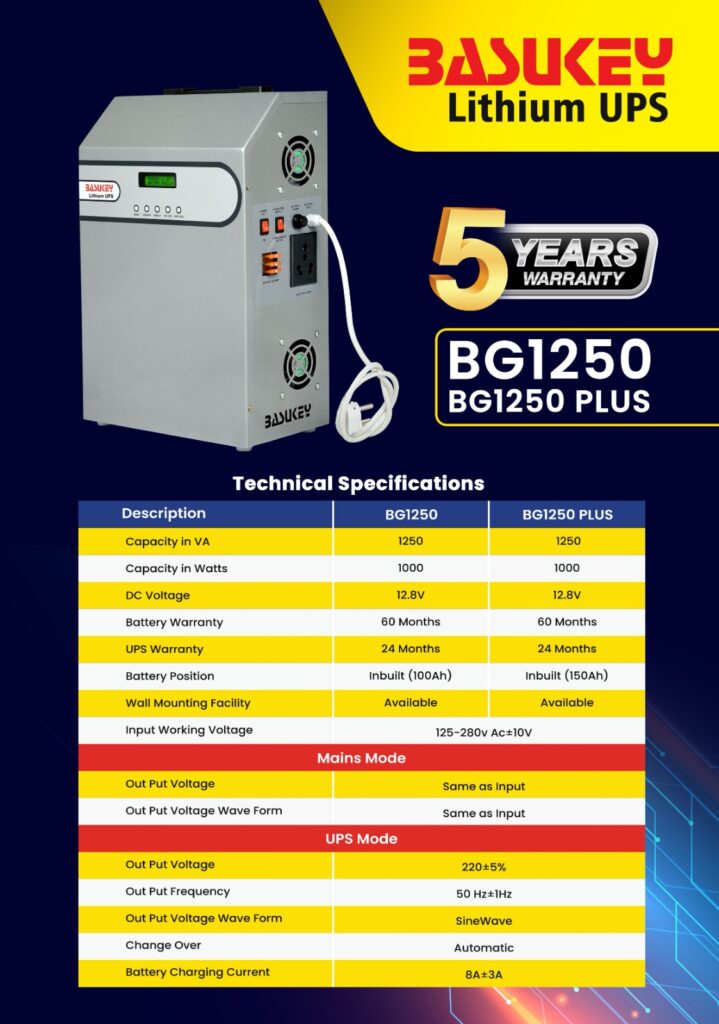Key Factors to Consider When Upgrading to a Lithium UPS System
Key Factors to Consider When Upgrading to a Lithium UPS System. As energy reliability becomes increasingly critical for homes, businesses, and industries, Lithium-based Uninterruptible Power Supply (UPS) systems are emerging as a superior alternative to traditional lead-acid battery backups. Offering higher efficiency, faster charging, longer lifespan, and minimal maintenance, Lithium UPS systems provide a long-term power resilience solution. However, upgrading to a Lithium UPS requires careful evaluation to ensure compatibility, cost-effectiveness, and performance optimization. Below are the key factors to consider before making the switch.
1. Energy Requirements and Load Capacity
The first step in upgrading to a Lithium UPS is understanding your power consumption needs.
- Identify total power load (measured in kilowatts or kVA) to ensure the new system can handle critical appliances or industrial machinery.
- Consider peak demand fluctuations—Lithium UPS systems can handle sudden power surges more efficiently than lead-acid alternatives.
- Factor in backup duration requirements based on the number of hours of expected power outages.

2. Compatibility with Existing Infrastructure
A seamless upgrade to a Lithium UPS depends on compatibility with existing electrical and power backup systems.
- Voltage and Phase Requirements: Ensure the new UPS system aligns with the electrical setup (single-phase or three-phase).
- Integration with Solar or Renewable Energy: If using solar panels, check if the Lithium UPS supports hybrid configurations to store excess energy efficiently.
- Wiring and Circuitry: Some setups may require modifications for higher energy efficiency.
3. Battery Chemistry and Performance
Not all lithium batteries are the same. The two most common types used in UPS systems are:
- Lithium-Ion (Li-Ion): Offers high energy density and fast charging, making it ideal for IT setups and general power backup.
- Lithium Iron Phosphate (LiFePO₄): Provides superior thermal stability, longer cycle life, and enhanced safety, making it preferred for industrial and critical applications.
4. Charging Speed and Energy Efficiency
Lithium UPS systems offer significantly faster charging times than lead-acid batteries, which means quicker recovery after power outages.
- Lead-Acid Batteries: Can take 8-10 hours to recharge fully.
- Lithium Batteries: Typically recharge within 1-3 hours, ensuring high availability.
- Smart Charging Features: Some advanced models offer adaptive charging algorithms that optimize efficiency and extend battery life.
5. Maintenance and Lifecycle Costs
One of the biggest advantages of a Lithium UPS is its low maintenance requirements and extended lifespan.
- Lead-Acid Batteries: Require regular maintenance, including water refilling and corrosion checks.
- Lithium Batteries: Maintenance-free with no periodic servicing needed.
- Longer Lifecycle: Lithium batteries last 8-10 years, compared to 3-5 years for lead-acid alternatives, reducing total replacement costs.
6. Safety Features and Thermal Management
Lithium batteries are generally safer than lead-acid batteries, but proper battery management systems (BMS) are essential for optimal performance.
- Overcharge and Over-discharge Protection: Prevents damage to the battery cells.
- Thermal Stability: Advanced LiFePO₄ batteries offer greater resistance to overheating and thermal runaway.
- Smart Monitoring and Alerts: Some Lithium UPS models include real-time battery health monitoring and remote diagnostics.
7. Cost vs. Return on Investment (ROI)
While Lithium UPS systems have a higher upfront cost, they offer better ROI over time due to:
- Longer lifespan (2-3x lead-acid battery life)
- Lower maintenance and replacement costs
- Higher energy efficiency (faster charge, lower power loss)
- Space savings and lighter weight
For businesses and industries relying on continuous power availability, upgrading to a Lithium UPS can provide ROI within 4-6 years.
8. Environmental Impact and Sustainability
As industries and governments shift towards sustainable energy solutions, Lithium UPS systems contribute to reducing carbon footprints.
- No hazardous lead or acid emissions
- Lower energy wastage compared to lead-acid alternatives
- Recyclability: Many manufacturers now offer battery recycling programs for lithium-based systems.
Conclusion: Making the Right Upgrade Decision
Upgrading to a Lithium UPS system is a strategic move toward greater energy efficiency, lower long-term costs, and enhanced power reliability. By evaluating key factors such as load capacity, battery chemistry, energy efficiency, safety, and ROI, you can ensure a smooth transition that meets your power backup needs. For critical applications—such as data centers, healthcare facilities, and industrial automation—Lithium UPS systems provide unmatched performance and reliability. As battery technology advances, investing in lithium-based energy storage will become a future-proof solution for power resilience.
Next Steps:
- Conduct an energy audit to determine your power backup needs.
- Compare different Lithium UPS models and battery chemistries.
- Consult with an energy expert for seamless integration with existing infrastructure.
